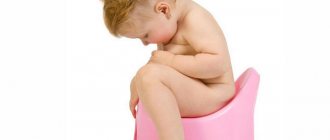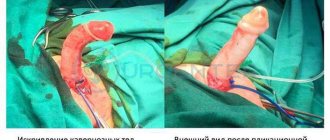Puberty is a time when complex endocrine processes occur in a girl’s body, shaping her somatic and sexual development. During this period, the girl’s body reaches biological and sexual maturity and the girl is anatomically and functionally ready for procreation.
There are two phases of puberty. The first - prepubertal - is characterized by a growth spurt, the appearance of secondary sexual characteristics (mammary glands and sexual hair growth) and ends with menarche - the first menstruation. In the second phase, the formation of secondary sexual characteristics is completed and a regular menstrual cycle is established.
Late or early onset of puberty is not always associated with a pathological process, and careful questioning often reveals that the mother or grandmother also began menstruation earlier or later compared to their peers. If this worries the girl or her mother, then it is necessary to consult a pediatric (teenage) gynecologist.
Acceleration of growth rates is observed at the age of 9–11 years, enlargement of the mammary glands – at 10–11 years, sexual hair growth – from 11–12 years. Menarche is usually observed at 12–13 years of age, and a regular menstrual cycle is established within 1.5–2 years from menarche. During this time, the break between menstruation can be up to 1 – 3 or more months. And a regular ovulatory cycle appears in girls five years after menarche.
Age of puberty, when does puberty begin, at what age does it start?
Puberty occurs between the ages of 12 and 16 years. Sarklinik believes that the timing of puberty in certain groups and in individual boys and girls, boys, young men and girls varies significantly. What are the signs of puberty in boys ? Boys develop a mustache, a beard, an enlarged Adam's apple (Adam's apple), an enlarged penis and testicles, hair in the armpit and pubic area, and a rougher voice. What are the signs of puberty in girls ?
In girls, the mammary glands enlarge (mammary glands, breasts, boobs become fuller, rounder, larger), the shape of the pelvis (pelvic bones) changes, the external genitalia increase (labia majora and minora, clitoris), the skin of the labia darkens, hair appears under the armpits and on the pubis, pubic hair grows in a triangle, there is a sharp jump in growth.
Puberty of girls, girls, sex formula, female puberty
What is the age of puberty for girls ? Puberty in girls most often occurs between the ages of 12 and 16 years. When assessing the puberty of girls, the following are taken into account: P – pubic hair growth, pubic area; Ax – armpit hair growth; Ma – mammary glands, Me – menstruation (menstruation). At different ages, the sex formula changes.
The sexual formula P0 Ax0 Ma1 is observed between the ages of 8.6 and 12.0 years.
The sexual formula P1 Ax0-1 Ma1 is observed between the ages of 9.8 and 13.4 years.
The sexual formula P2 Ax2 Ma2 is observed between the ages of 10.2 and 13.5 years.
The sexual formula P3 Ax2-3 Ma3 is observed between the ages of 11.0 and 14.3 years.
The sex formula P2 Ax3-4 Ma3 Me+ is observed between the ages of 11.1 and 14.4 years.
The sex formula P2 Ax2 Ma3-4 Me+ is observed between the ages of 12.0 and 15.5 years.
The sex formula P3Ax2Ma3-4Me+ is observed between the ages of 12.8 and 15.7 years.
The sex formula P3 Ax3 Ma3-4 Me+ is observed between the ages of 13.5 and 16.9 years.
0 is the absence of a trait, 3 - 4 is maximum sexual maturity. During puberty, girls begin to develop mature eggs. There is a change in behavior and psyche and attraction to guys.
Pubarhe
The onset of pubic hair growth usually occurs after thelarche, around 11–12 years of age, and is often accompanied by axillary hair growth. Pubarche usually occurs after thelarche, but simultaneous development of thelarche and pubarche is also normal. In representatives of the black race, pubarche may precede thelarche, which is not a pathology.
The development of pubic and axillary hair occurs secondary to an increase in the concentration of circulating androgens. Sometimes the concepts of pubarche and adrenarche are used as synonyms, but this is not entirely true. Pubarche is the development of pubic hair, which occurs under the influence of adrenal androgens after the age of 10 years in the stage of pubertal development, and adrenarche is the activation of androgen synthesis in the adrenal glands, which occurs between the 6th and 8th years of life and precedes the onset of pubertal development.
Stages of puberty, stages
What are the stages of puberty ? Experts distinguish 5 stages of puberty: stage 1, stage 2, stage 3, stage 4, stage 5. Stage 1 – childhood, prepubertal period. Stage 2 – the beginning of adolescence, the beginning of puberty. Stage 3 - the beginning of adolescence, the first period of puberty, stage 4 - continuation of adolescence, the second period of puberty, stage 5 - the onset of sexual biological maturity, the end of the puberty period.
What is early, premature puberty?
Early puberty , or precocious puberty, is associated with the appearance of secondary sexual characteristics in girls before age 8 and in boys before age 10. Puberty is characterized by hormonal changes and increased function of the gonads. Puberty completes the formation of secondary sexual characteristics, menstruation (menstruation, menstruation) appears in girls, and wet dreams (involuntary ejaculation) appear in boys. There is also a rapid increase in body length and weight (height in cm and weight in kg) and subcutaneous fat layer increase, especially in girls. By the end of the maturation period, short stature or excessively high growth are clearly defined. During puberty, acceleration processes become more obvious.
Menstrual cycle
The hypothalamus, pituitary gland, ovaries and uterus are components of the female reproductive system that take part in the establishment and regulation of the menstrual cycle and function through positive and negative forward and feedback connections. In a genetic female fetus, at the 20th week of development, the ovaries contain 6-7 million germ cells, the number of which decreases to 2 million at the time of birth and to 300,000 before the onset of puberty.
The menstrual cycle normally lasts 28 days (variations from 21 to 35 days). Only 15% of women have a 28-day menstrual cycle. The menstrual cycle is most irregular during the 2 years after menarche and 3 years before menopause (the last menstruation in a woman’s life). Anovulatory cycles during these periods are 6-35%.
The menstrual cycle is divided into two 14-day phases: I - follicular and II - luteal, characterized by changes in the ovaries during the cycle. These phases are also called proliferative and secretory, reflecting synchronous changes in the endometrium during the same period of time. These cyclic changes occur in the superficial, functional layer of the endometrium (both its compact and spongy layers), whereas the basal layer of the endometrium is insensitive to hormonal stimuli and remains intact throughout the menstrual cycle (regenerative zone).
During the follicular phase of the cycle, the release of FSH by the pituitary gland causes the development of primary ovarian follicles. Ovarian follicles produce estrogens, which, in turn, stimulate endometrial proliferation. Under the influence of FSH, usually only one of these follicles (dominant) reaches maximum development - the stage of a mature (tertiary, Graafian) follicle; others stop developing at different stages (primary, secondary follicles).
In the middle of the menstrual cycle, around the 14th day, in response to the achievement of the maximum concentration of estrogens synthesized by granulosa cells of the follicles, a peak in LH secretion by the pituitary gland occurs. This LH peak stimulates ovulation - the rupture of the wall of the mature follicle and the release of the egg, which almost immediately enters the lumen of the ampullary part of the fallopian tube.
After ovulation, the second, luteal phase of the menstrual cycle begins. The dominant follicle in which ovulation took place accumulates luteal pigment and develops into the corpus luteum. The corpus luteum, next to the secretion of estrogen, begins to produce progesterone, which promotes secretory changes in the endometrium (decidualization, decidual reactions - accumulation of glycogen, as well as increased vascularization) to ensure implantation of a fertilized egg.
If fertilization does not occur, the corpus luteum degenerates and progesterone (and estrogen) levels decrease. With a sharp decrease in the level of progesterone and estrogen in the endometrium, ischemia and desquamation of the epithelium of the functional layer develops - menstruation (menstrual phase).
Follicular phase
Canceling the influence of estrogen and progesterone at the end of the luteal phase of the previous menstrual cycle leads to a gradual increase in the release of FSH by the pituitary gland. In turn, FSH stimulates the growth of 5 to 15 primordial follicles (eggs, the development of which is stopped at the diplotene stage in the prophase of the first meiotic division, surrounded by a single layer of granulosa cells), which means the beginning of the first, follicular, phase of the new menstrual cycle. The development of primordial (primary) follicles to the Diploten stage of prophase of the first meiotic division does not depend on the action of gonadotropins.
Of these primordial follicles, usually only 1 becomes dominant and matures into a preantral, secondary follicle (an oocyte surrounded by the zona pellucida with several layers of granulosa and theca cells). The development of preantral follicles is gonadotropin dependent.
Selection of the dominant follicle occurs on days 5-7 of the menstrual cycle. The preantral follicle secretes estrogens, accumulates follicular fluid and matures to the stage of ovulatory (tertiary, Graafian) follicle. FSH is responsible for inducing the synthesis of LH receptors and the aromatase enzyme, which is responsible for the conversion of androgens to estrogens in the growing follicle. Estrogens act synergistically with FSH and increase the number of FSH receptors in granulosa cells of the follicle, as well as their mitotic activity.
The follicle develops and reaches preovulatory maturity through the production of estrogens, which enhance its maturation and also stimulate the formation of FSH and LH receptors in an autocrine manner. Estrogens are produced by the “two-cell”, “dagonadotropin pathway”. The cells of the inner theca membrane of the follicle (papa cells) produce androstenedione in response to LH stimulation, and the granulosa cells of the follicle, under the influence of FSH and with the help of the aromatase enzyme, convert this androstenedione into estradiol.
The synthesis of androgens, which are also converted into estrogens, stimulates LH. Androgens promote atresia of non-dominant follicles. Androgens in high concentrations are subject to 5a-reduction into more active androgens. A premature increase in LH secretion also reduces the mitotic activity of granulosa cells and contributes to degenerative changes in the follicles.
An increase in the level of circulating estrogens, according to the law of central negative feedback, affects the secretion of FSH by the pituitary gland. This leads to the withdrawal of gonadotropins supporting other developing follicles. The dominant follicle is protected from a decrease in FSH levels due to the increased concentration of FSH receptors in it. In addition, increased vascularization of the inner layer of theca cells also contributes to greater sensitivity of the dominant follicle to the action of FSH. By suppressing the secretion of gonadotropins by increasing its own estrogen production, the dominant follicle optimizes its own development by stopping the growth of other follicles.
Ovulation
At the end of the follicular phase, estrogen levels increase significantly and reach a critical (peak) value (> 200 pg/ml), which is observed for about 50 hours, which is a trigger for the anterior pituitary gland to release the maximum amount of LH. This positive feedback between rising estrogen levels and rising LH concentrations is enhanced by low progesterone levels.
Ovulation occurs due to LH-induced rupture of the follicle and release of a mature egg approximately 34-36 hours after the onset of the LH rise or 10-12 hours after the LH peak. The LH surge initiates the resumption of meiosis in the oocyte, causes luteinization of the granulosa cells of the follicle and stimulates the synthesis of prostaglandins and progesterone necessary for follicle rupture. Degenerative changes in the follicle wall can develop due to the destruction of collagen, which leads to both passive reduction and rupture of the follicle. Prostaglandins and lysosomal enzymes (proteases) cause degenerative changes in the follicle wall.
Ovulation is accompanied by the completion of the first meiotic division with the release of the first polar body. The egg usually enters the fallopian tube and, thanks to the movement of the cilia of its epithelium, moves into the uterus. This process usually lasts 3 to 4 days. If fertilization of the egg does not occur within 24 hours after ovulation, it degenerates.
Luteal phase
After ovulation, the luteal phase of the cycle begins. Granulosa cells and the inner thecal membrane of the follicle line its wall and, under the influence of LH, form the corpus luteum. Life expectancy and steroidogenic activity of the corpus luteum depend on prolonged tonic LH secretion, which leads to an increase in the secretion of progesterone by the corpus luteum. Normal function of the corpus luteum requires optimal preovulatory development of the follicle (i.e., adequate FSH stimulation) and constant tonic LH support.
The corpus luteum synthesizes estrogens and a significant amount of progesterone, causes further development of glands and secretory changes in the endometrium (vascularization, accumulation of glycogen), which are preparatory processes for implantation of a fertilized egg. The peak secretion of progesterone by the corpus luteum occurs around the 8th day after the LH peak, which affects the maturation of the secretory endometrium and suppresses follicular growth.
Each day of the luteal phase is accompanied by certain microscopic changes in the glands and stroma of the endometrium. Implantation usually occurs on days 22-23 of the menstrual cycle, coinciding with the maximum intracellular apocrine secretory activity of endometrial cells.
If fertilization occurs, the developing trophoblast begins to synthesize human chorionic gonadotropin (hCG), a glycoprotein similar to LH, which provides support for the function of the corpus luteum (development of the corpus luteum of pregnancy), i.e. stimulates the secretion of estrogen and progesterone, which is necessary to maintain the endometrium until the development of the placenta and the beginning of its hormone-producing function (8-10 weeks of gestation). Insufficient function of the corpus luteum causes the so-called luteal phase defect of the cycle (luteal phase insufficiency), which is considered one of the possible causes of abortion at an early stage.
If fertilization, and therefore the synthesis of hCG caused by it, does not occur, the corpus luteum degenerates (corpus luteum of menstruation), the level of progesterone and estrogen decreases, hormonal support of the endometrium does not occur, ischemic changes develop in it and menstruation occurs - rejection of the functional layer of the endometrium.
Puberty disorders
The increasing motor and neuropsychic activity of adolescents leads to increased tension in the metabolism, endocrine system, and nervous system. The processes of general excitation intensify, the stabilization of conditioned reflexes becomes more difficult, the blood supply to the brain somewhat deteriorates, and therefore fatigue and phase states develop more easily. Disorders of the nervous system, psychoneuroses, neurasthenia, depression, obsessive neurosis, and vegetative-vascular dystonia are often observed. The lability of the function of the autonomic nervous system increases, frequent stabbing pains in the heart area, palpitations, and cardioneurosis. Psychopathic manifestations are possible. Pediatricians, therapists, endocrinologists, reflexologists, and reflexologists often call the period of puberty transitional, since at the beginning of it children have not yet become adults, but they no longer feel like children. This period is especially difficult psychologically. The psyche of a teenager is very vulnerable. To prevent pathological deviations in the mental and physical development of a teenager, preventive visits to a psychologist are important. Disorders of puberty may be observed (lag, delay, slowdown, early, premature development).
Drugs
Drugs are so dangerous to health that their use and sale are strictly prohibited. Most drug addicts develop severe physical and mental disabilities, leading to tragic consequences.
Inhalation of chemicals
contained in various types of aerosols, has an effect on the nervous system similar to alcohol, only much more dangerous. The chemicals can seriously damage the brain, liver, kidneys and lungs. Snorting from a plastic bag can cause death by suffocation.
Sex life of teenagers
Often boys and girls, boys and girls, teenagers are interested in such issues as puberty, sex life, wet dreams, genitals, labia majora, labia minora, genitals, erection, penis, vagina, clitoris, virgin hymen, sexual maturity, sexual intercourse. Teenagers are also interested in the following questions. What is the male reproductive organ? Which gender is more interesting? What is nudism? Who are naturists, nudist girls, puberty name? How long does the process of puberty last? What is the norm of sexual development, standards? Why does late puberty and impotence occur in children? What are the dangers of frigidity, prostatitis, early ejaculation, vaginismus? How to achieve orgasm for a girl? Why isn't the dick worth it? Why is my penis crooked? How to prolong sex? Why is the vagina dry? Why is the clitoris swollen after sex? Why is the vagina narrow? What should you do if it drips from your penis and burns in your vagina?
Dear teenagers, if you have any of the above questions, you can consult a doctor on the topics that interest you absolutely free on the sarclinic website and get up-to-date answers. The site and the doctor are waiting for your questions.
Hygiene features
One of the main points during menstrual bleeding is basic adherence to personal hygiene rules. It is necessary to wash yourself at least twice a day, morning and evening, and even better, every time you change a pad or tampon, since menstrual blood acquires an unpleasant odor from contact with air. In addition, it is an ideal environment for bacteria. Tampons or pads should be changed as they become soaked, but at least every four hours. The reason for such frequent changes is always written in the insert of the tampon package: toxic shock syndrome (TSS). You can guess that it’s time to change by the slight feeling of discomfort.
What hygiene product to use during menstruation, pads or tampons, a woman is free to decide for herself, but for a girl, explanations from her mother and a conversation with a gynecologist will be necessary.
Tampons can be used from the start of menstruation, provided:
— choosing the right size and absorbency of the tampon;
— correct insertion of the tampon;
- if the girl does not have certain medical contraindications.
Girls whose hymen is not broken can use tampons specially designed for this purpose. If you cannot insert a tampon even after several attempts, you should consult a gynecologist. The hymen (hymen) may be too small to allow a tampon to be inserted. At least 2% of teenage girls have difficulty inserting a tampon precisely for this reason. In such cases, gynecologists recommend using other hygiene products.
In the last days of menstruation, when a woman begins to lead a more active lifestyle compared to the first days of menstruation, it is much more convenient to use a tampon. At night, it is better to prefer pads, especially since there are special ones - “night ones”, longer and wider in size. In general, there are no strict rules for choosing hygiene products; this largely depends on the individual characteristics of the woman’s development and lifestyle.
It is not recommended to take a bath during menstruation. It is best to limit yourself to a warm shower and washing. You should avoid swimming in pools, rivers, the sea, and natural bodies of water.
An important point during menstruation is nutrition. During this period, it is necessary to provide the body with all the necessary elements: vitamins, minerals, calcium, magnesium, fiber. It is also necessary to balance the combination of proteins, fats and carbohydrates. It is worth limiting the girl’s consumption of sweet, salty and overly spicy seasonings.
Many girls complain that in the period preceding menstruation, their skin becomes covered with small pimples. Sex hormones are to blame for this. Don’t worry, they will disappear on their own with the end of your critical days. But if they do not go away on their own, then you can seek advice from an endocrinologist or gynecologist to rule out serious disorders in the body, and, preferably, a dermatologist who will prescribe external medications aimed at improving the condition of the skin. At home, we can recommend using light antibacterial masks and, of course, following a non-strict diet.
In addition, during menstruation it is better to avoid sports competitions, heavy lifting, hypothermia, and monitor the timely emptying of the bladder.
Puberty: treatment, how to treat puberty disorders
Sarklinik provides treatment for disorders of puberty in Saratov , treatment of disorders of puberty in Russia, treatment of retardation, treatment of delayed puberty, treatment of premature puberty, treatment of early puberty, treatment of sexual dysfunction, treatment of late delayed puberty in boys and girls, guys and girls, children and teenagers. At the first consultation, the doctor will tell you how to treat puberty disorders and how to cure delayed puberty.
There are contraindications. Specialist consultation is required. Make an appointment and consultation.
Text: ® SARCLINIC | Sarclinic.com \ Sarlinic.ru Photo: (©) Zastavkin | Dreamstime.com \ Dreamstock.ru The guy and girl shown in the photo are models, do not suffer from the diseases described and/or all coincidences are excluded.
Related posts:
Help enuresis, where to get treatment for enuresis in Russia, Saratov
Birth trauma, how to avoid birth trauma?
Birth trauma of newborns, treatment of birth injuries, rehabilitation, recovery from injuries
The child does not sit, what time do children sit, when does the child begin to sit, at what months
Calomasania in children: causes, treatment in Saratov, how to treat calomasania in Russia






